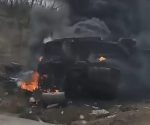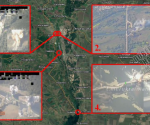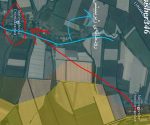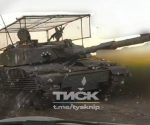Regardless of the trouble brewing in Deir Ez Zor, the Americans lose another war
First it was one hundred. Now, the figure has trebled so that three hundred Russians, according to UK and US corporate-media, died in an attack by US-led coalition forces on the 7th February in Deir Ez Zor province. Why don’t they just make it a round Masonic three hundred and thirty three and be done with it? As usual, with any psyop, the dishonesty is plain to see in the detail. Take this extract from Reuters, for instance:
The timing of the casualties coincided with a battle on Feb. 7 near the Syrian city of Deir al-Zor where, according to U.S. officials and associates of the fighters involved, U.S.-led coalition forces attacked forces aligned with Moscow’s ally, Syrian President Bashar al-Assad.
According to this, the casualties happened at the same time as the attack. It is left to the reader to assume the connection.
Meanwhile, Moscow maintains that 5 mercenaries from Russia might have been killed in the incident. The ISIS Hunters of the 5th Assault Corps of the Syrian Arab Army (SAA) put out a statement that they had had 20 soldiers killed, but that other SAA units with them had lost more than that. The brutal truth of the matter is that the incident will be a footnote in the history of the invasion of Syria, but it’s big news now because the British and US media has obviously been tasked with trying to demoralise Russians; that they evidently realistically hope to achieve this indicates the Himalayan levels of hubris. It’s called “fake news” in Russia.
And in the real world, the data from the ISIS Hunters is amongst a good deal of information which has become available, or has been found in addition since the publication of the FBEL article entitled US death throes in Syria: supporting ISIS with attack helicopters. By this new data, suppositions previously found in various places on the internet, and covered in said article, can perhaps be given a little more weight in terms of certainty. The data also continues to confirm that the author was absolutely correct to identify certain problems for the Kurds in Deir Ez Zor occuring as a consequence of the Turkish invasion of Afrin.
That FBEL article opened with the following:
The data from Deir Ez Zor province that begins to form the big picture suggests there may be a big readjustment happening, with the Arabs coming to terms with a few realities about the prospect of Kurdish overlordship on behalf of the United States military, and with the Kurds realising that they are desperately overstreched.
As it turns out, the notion of a prospect of Kurd/Arab tension in Deir Ez Zor forgot the ultimate consequence of the other prediction: the Kurds would be so overstreched that they would abandon Deir Ez Zor altogether. This is exactly what many reports are saying has already happened. The following is from Al Masdar News, 15th February:
Military (proper) and military analyst sources note that Syrian Kurdish forces of the People’s Protection Units (YPG) have mostly withdrawn from areas controlled by the US-led coalition in the eastern countryside of Deir Ezzor province, handing over control to another coalition partner militia known as the Deir Ezzor Military Council (DMC).
Rather intriguingly, all the way back at the end of January, Qasion News Agency (described as Syrian, and based in Turkey) reported this:
Senior military sources in the Syrian opposition forces told Qasioun News Agency that negotiations are running with the U.S. to enter Deir Ezzor.
The announcement came after seniors in Syrian Democratic forces SDF announced and threatened to withdraw from Deir Ezzor, as they considered that “It is not important more than Afrin” in respond to the U.S. who said that Afrin is “not their interest”
It’s not clear what is meant by the US entering Deir Ez Zor, but it appears that the Kurds didn’t want to remain themselves even at the very commencement of the Turkish Operation Olive Branch.
The previous FBEL article (as linked to above) discussed the possibility of a resurgence of ISIS to hold parts of eastern Syria that the Kurds were no longer feeling able to occupy – but this did not account, of course, for those eastern Arab Syrians who are, for one reason or another, hostile to the Damascus Government. The Deir Ez Zor Military Council (the DMC), as mentioned in the Al Masdar extract, are of this type. Always described as being ex-FSA and ex-ISIS, these are surely the same mercenaries that can be associated with the first spurt of the Islamic State as it transformed from being al-Qaeda in Iraq and Anbar Province and migrated across the border into Syria – as written about in the 2015 FBEL article to be found here.
Look at a map of the current situation, and notice that there is an area in the south east corner of Syria that the US-led coalition allows to remain under ISIS control. It abuts onto Anbar. Incidentally, ISIS also still controls the Euphrates valley in areas where it neighbours Anbar, and it’s there that the world is being told that the US remains engaged in fighting ISIS. However, and as usual, all might not be as it seems. Al Masdar also reported today – and the source was the ISIS-linked Amaq media centre – that the US has bombed SDF allies at Ash-Sha’fah “by mistake”. In all the shinannigans going on in Deir Ez Zor, this shouldn’t be taken at face value.
The American allies that remain in Dier Ez Zor are a rum lot. The Wikipedia page on them states that they are comprised of “former Islamic State fighters which have been re-trained by U.S. forces”. Their leader is called Rashid Abu Khawla – who is best described as a bandit. Indeed, analysis on the US’s “flawed partners” in eastern Syria by the Washington Institute for Near East Policy concluded
Washington should also keep a close eye on Abu Khawla to keep his forces from alienating Syrians in liberated areas. Otherwise, the war against ISIS may be supplanted by a new conflict, risking the gains of the past three years while heightening U.S.-Russian tensions.
And when we read another extract from the same analysis, we can realise that tension between the SDF and the local Arab population in Deir Ez Zor doesn’t need a “Kurdish overlord” element to it;
Yet it remains unclear how residents of Deir Ezzor province will feel about commanders like Abu Khawla taking charge of their communities. Although it is impossible to confirm the veracity of the many allegations against him, locals are likely to believe them, perhaps spurring some of them to forcefully oppose the DZMC’s presence.
In the said previous FBEL article, there was a not-so-brief mention of an incident at a placed called al-Shahil where the introduction of ex-ISIS members into the SDF appears to have had something to do with the murder of a local man – which made the villagers so irate that they basically rose up against the SDF in order to extract justice upon the one of their number who had done the deed.
The fears expressed in the Washington Institute’s analysis of October 2017 have been realised. Worse is very likely set to come, especially if the Kurds, who might have curbed the tendency to lawlessness in their bandit allies, have actually abandoned Deir Ez Zor leaving it in the hands of the DMC. The US doesn’t need a resurgence of ISIS to control Deir Ez Zor, because it has the DMC.
And it appears that the DMC were the characters who fought against the pro-Syrian Government troops on 7th February. The ISIS Hunters reported that a joint convoy of ISIS and SDF (therefore the DMC) attacked SAA positions in the village of Khasham (or Khsham). When the Syrians repelled them, the US launched the airborne strikes that were evidently so punishing.
Interestingly, the ISIS Hunters said that the ISIS/DMC forces retreated to the Conoco gas fields. This facility featured in the said previous FBEL article which covered a theory going about the internet that pro-Syrian forces were moving to capture it as per a deal with the YPG element of the SDF. The ISIS Hunter story doesn’t admit as much, but it begins to look like the US reaction might very well have been stoked by a move to take the Conoco facility.
Whether the intent by the pro-Syrian forces came as a consequence of ISIS/DMC provocation, or whether it was the result of a longer-term plan is still not clear. If it was the latter, then the ISIS Hunters story was economical with the truth – and this shouldn’t be a surprise, given that the Russians are being very tight lipped about this incident.
What appears to be the case, however, is that there is a misunderstanding about ownership of the Conoco gas fields. ISIS were relieved of them in September 2017 by the SDF, but in October came the following news:
Moments ago, reports came in that Russian Ground Forces troops entered the Koneko Gas Field and its attached company headquarters area in eastern Deir Ezzor province at the invitation of Kurdish-led forces.
The information, disseminated by Syrian military reports, claims that an agreement has been brokered between Russia and the US-backed Syrian Democratic Forces whereby the Syrian government will be allowed to assume control over the gas field.
Note, the Al Masdar correspondent did indicate that the reports might not be true – which they evidently weren’t according to the information that is about to be presented. The “Russian Ground Forces” mentioned in the piece were very likely the private military contractors working for Wagner whose presence in Syria really came to the fore after the February 7th incident, but who evidently have popped up in the history of Conoco before. This deal between the Kurds and the Syrians is a much-told myth if it isn’t true, because it was cited as the reason for the approach of pro-Syrian Government forces on the Conoco fields on February 7th; the following is an example from Twitter:
Yesterday the #SAA had an agreement with the #YPG to hand over the oil fields in the area Conico and Al Omar. But the Deir Ezzor Military Council didn’t accept the deal and opened fire at the #SAA allies then called for #USAF air strikes The clashes continued for 3 hours.
This tweet notes an important detail: the DMC occupation of the Conoco gas fields – something that the aforementioned Washington Institute piece also informs of. Indeed, it was the DMC that initially took the Conoco gas fields, and so even if the Kurds did negotiate it away to the Syrian Government, it seemingly wasn’t in their power to deliver. The Syrians, perhaps, should be wary of deals to save the Kurds in Afrin.
Frankly, there is far too much smoke for there not to be fire in terms of activity, historical and current, around the Conoco facility. We hear now that the Syrians are building up forces, and fortifications, in that area around Khsham where the Syrians previously managed to cross the Euphrates and create a beachhead. Earlier this week Fayssal Mikdad, Syria’s Deputy Foreign and Expatriates Minister, issued a warning that was, from its context, aimed at the USA: “the Army will down any jet that launches an assault on Syria and that is not a mere threat”. If there was ever a deal between the Syrian Government and Russia for the supplying of measures for the “recovery and development of oil and gas fields in Syria” – something previously rumoured at – there definitely is now. Also this week, SANA reported the Russian Minister of Energy Alexander Novak as confirming that a “roadmap” for the “cooperation in the oil and gas sector between Russia and Syria” had been signed off. Does it all mean that the Syrians and Russians mean business on the other side of the Euphrates?
Judging by the clamorous, clanging anti-Russian psyop that has the US and UK corporate-media spinning and rolling around like church bells, it is a possibility that the Anglo-Globalist cabal fears – but being powerless, finds itself having to resort to its “magic” to try and create doubt in its enemy. And feelings of powerlessness are certainly betrayed in some of the loud-thinking that is coming out of Anglo-Globalist policy gurus. The Brookings Institution – the thinktank of Which Path to Persia? fame, published an article this very week in which some possible roles for the USA military in Syria were sounded out:
How much will it go after al-Qaida, which has quietly built a substantial following in Idlib province? To what extent is it there to push back on Iran? To fight the Assad regime? To train, equip, and advise violent non-state actors as they seek to do so?
None of the options are feasible (but that would take another article to explain), and there is no surprise that there is this conclusion: “the residual U.S. force presence in Syria may be just enough to get into trouble, but [is] unlikely to accomplish very much.” The title of the piece? After 7 years of war, Assad has won in Syria. What’s next for Washington? The author has an answer. A bloody nose, massive humiliation (and on the MAGA watch too), and US Marines doing what they were born for: hanging from evacuation helicopters like fat buttocks out of the back of badly fitting trousers.


















